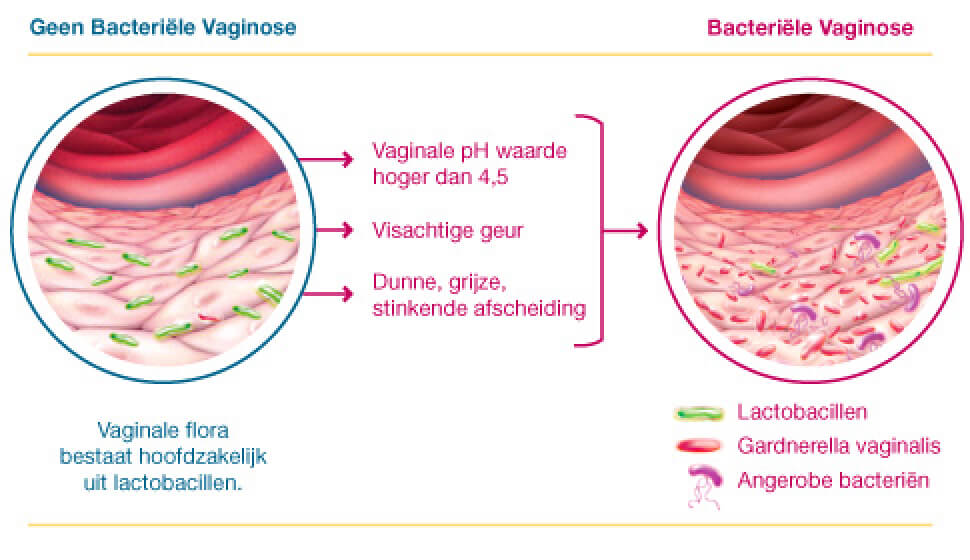What is Bacterial Vaginosis?
Bacterial Vaginosis is the most common cause of abnormal vaginal discharge, such as foul-smelling discharge. The high number of reinfections and the negative impact it has on the (sexual) well-being of many women makes it a significant problem.
Bacterial Vaginosis is a vaginal infection that results from a disruption of the bacterial balance. Due to this disturbance, the number of good bacteria (lactic acid bacteria) that belong in the vagina decreases, and pathogens such as Gardnerella bacteria take over. Lactic acid bacteria, also called Lactobacilli, produce lactic acid. This lactic acid ensures that the vagina is acidic, preventing disease-causing bacteria from developing in too large numbers under normal circumstances.

In Bacterial Vaginosis, due to a disturbance in the balance, certain bacteria,
such as Gardnerella and anaerobic bacteria, take over and the vagina becomes less acidic.
This usually results in an often unpleasantly smelling and gray-white discharge.
Half of the women with Bacterial Vaginosis have no symptoms, while the other half
mainly complains about (foul-smelling) discharge.
In Short
- It is normal for bacteria and fungi to live in the vagina.
- In bacterial vaginosis, certain types of bacteria dominate.
- It is a disturbed balance and not a vaginal infection.
- The result is an unpleasant and smelly discharge.
- Only rinse the vagina with lukewarm water, especially do not use soap and vaginal douches, as their use can cause bacterial vaginosis.
A disturbance of the balance/acidity can have various causes, the main ones being:
- Vaginal douching, washing with soap, or using intimate sprays. Keep the vagina clean simply by rinsing only the outside with lukewarm water. Do NOT use soap or similar products. The inside of the vagina has a “self-cleansing” ability, even during menstruation, and you should absolutely not clean it.
- Normal menstruation. Due to the blood, the vagina can also become less acidic and cause bacterial vaginosis. Many women also tend to wash excessively or douche vaginally during menstruation, which only increases the risk.
- Use of medications such as antibiotics, corticosteroids, or an IUD for contraception can disrupt the vaginal flora.
- Sperm is not acidic and can cause the environment in the vagina to become less acidic. If you have sex without a condom, unprotected sex can contribute to the development of bacterial vaginosis. Use a condom if you are sensitive to this.
- Other causes. Many causes are still unknown, which is why bacterial vaginosis can unfortunately occur more often. Recent research indicates that new or changing partners can also increase the risk. Women who have sex with women also have a higher chance of bacterial vaginosis.
Do I Have Bacterial Vaginosis?
In Bacterial Vaginosis, due to a disturbance in the balance, certain bacteria, such as Gardnerella and anaerobic bacteria, take over and the vagina becomes less acidic.
Bacterial vaginosis is characterized by:
- A white/gray non-grainy discharge smelling like fish
- Smelly vagina especially noticeable during sex
- Labia not red or inflamed
- No itching
- Usually no pain during sex or urination
- Decreased acidity
The most reliable method to distinguish for yourself whether you have Bacterial Vaginosis or a Candida infection is by measuring the vaginal acidity (pH).
In Bacterial Vaginosis, the vagina is usually less acidic than in the normal situation. In Candida infections, the acidity is usually normal.
With a vaginal pH test, you can determine at home whether the acidity of the vagina is normal or abnormal. If it is abnormal, there is a high chance, in combination with factors such as a thin, non-crumbly, gray and often fishy-smelling discharge, no other complaints of the vulva and vagina such as itching or pain during intercourse, that you have Bacterial Vaginosis.

What can I do about it?
If you have no symptoms or complaints but do have an abnormal acidity, you can restore it yourself by using Normaflor vaginal tablets.
If you have clear symptoms or complaints, consult your general practitioner. They will perform additional microscopic examination or take a culture for laboratory testing. In most cases, if a positive diagnosis is made, an antibiotic treatment will be prescribed. This can consist of a single dose of 4 tablets of Metronidazole (Flagyl) 500mg or 1 tablet of 500mg twice daily for 7 days.
Evagynal is a proven effective treatment without antibiotics. Evagynal is available over the counter at pharmacies, without a prescription from your doctor.
How can I prevent it from recurring?
Metronidazole initially works well to cure Bacterial Vaginosis. However, 30% of women get a reinfection within one month after the treatment and 60% within three months.
This is because after treatment with metronidazole, the vaginal pH does not recover quickly enough, and metronidazole has an inhibitory effect on the regrowth of beneficial Lactobacilli. You can restore the vaginal pH immediately after a course of metronidazole by using Normaflor vaginal tablets. Normaflor restores the pH and promotes the growth of beneficial Lactobacilli, thereby restoring the balance of the vaginal flora and halving the chance of reinfection. To Normaflor
Is it harmful?
Bacterial Vaginosis is often dismissed, even by doctors, as a harmless vaginal discharge complaint.
However, this is not the case. Bacterial Vaginosis during pregnancy increases the risk of miscarriage, premature birth, preterm labor activities, or premature rupture of membranes. Outside of pregnancy, Bacterial Vaginosis is associated with frequent urinary tract infections (in 30% of cases), inflammations of the uterus, fallopian tubes, and peritoneum. It also increases the risk of contracting Human Papillomavirus, HIV, or other sexually transmitted diseases.
Bacterial Vaginosis is therefore less harmless than often assumed, and detection and treatment are preferred, even without symptoms.
Take the test
Do you have abnormal or foul-smelling discharge? Experiencing itching and pain during sex? Then there’s a high chance you have bacterial vaginosis or a vaginal fungal infection.
